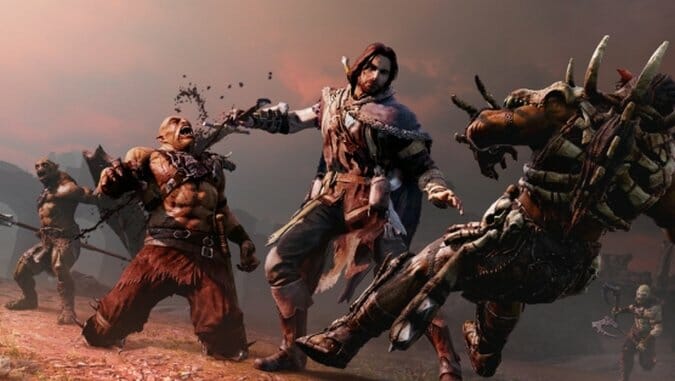Middle-earth: Shadow of Mordor: My Semi-Precious

I’ve never cared much for The Lords of The Rings. Tolkien’s over-descriptive prose and Jackson’s lengthy film adaptation of that prose bore me in equal measure. However, I’ve always had a fondness for videogames set in Middle-Earth (particularly Stormfront Studios’ stab’ em up The Lord of The Rings: The Two Towers) because they’re generally fun, competent games. It was with this cautious optimism that I loaded up Shadow of Mordor.
An hour in and we weren’t off to a great start.
The tutorial, which reveals how Gondor Ranger Talion died and was revived with supernatural powers, begins as an impressive flashback-structured sequence that ends with a gruesome cutscene where Talion and his family are slaughtered by a trio of Sauron’s top-level henchmen. Talion’s son and wife, who are given no real characterization to speak of, die to kickstart his grimdark quest for vengeance. It’s a story that shines in little moments, like when Talion and the Wraith sharing his body bicker like an old couple, or any time that the machiavellian munchkin Ratbag opens his mouth to speak. However, with regards to having a compelling narrative or protagonist, Mordor’s tale is a miss, and it’s hard not to feel disappointed that the writer(s) didn’t fashion something more worthwhile witxh the richness of Tolkien’s universe at their disposal. The plot quickly becomes about an angry dude and an angry ghost working through their respective emotional problems by rending heads from necks, thwarting the dark lord’s plans and occasionally rescuing prisoners who have been captured by the forces of evil.
The story missions range from enjoyable enough to downright infuriating. Shadow of Mordor’s primary strength is its robust, rhythmic combat; too bad a lot of these missions are sneaking sequences where if you’re seen, you have failed. The stealth options in the game are plentiful but they’re almost all geared toward encouraging the player to engage the enemy (killing them stealthily, getting close enough to brainwash them into becoming an ally, rigging traps to thin ranks before you engage). These particular missions force you to evade foes, which is a task that Mordor isn’t able to accommodate that well since the wall-climbing controls are sluggish and often unresponsive, especially when you’re trying to get somewhere fast. Luckily the combat controls are much more responsive.
Mordor’s combat system is a brutal, modified version of the one found in the Arkham games, but instead of knocking out foes, you’re eviscerating and decapitating them. Like in Arkham, the key to victory here is having a good rhythm—knowing instinctively when to dodge and parry, and when to slash at weaker foes, whittling down the group’s number until there are only you and the stronger units left. That’s when you start taking bigger risks, opening yourself up more so you can land devastating attacks. It’s a satisfying system that presents a stark challenge and rewards you for overcoming it with points used to buy Talion new abilities and gruesome finishing moves. That’s why it’s a bit of a head-scratcher that so many missions in the game don’t revolve around that combat and, instead, focus on unforgiving stealth or, worse, following characters from checkpoint to checkpoint to fetch items. A mission where you must poison orc grog wells undetected and a tedious, poorly written damsel in distress escort mission are particularly frustrating.
Despite being the worst part of the game, the story mode is still interesting to me because of the tug of war that exists between it and the game’s Nemesis system, which allows the player to have a hand in crafting the story of Sauron’s army of Uruks and Talion’s relationship to that army. The Uruks have a hierarchy where ruthlessness and betrayal are the quickest ways for an ambitious grunt to become a war chief. By weakening a captain and interrogating him, the player can learn the strengths and weaknesses of other units in the army, information that turns out to be surprisingly valuable. For example, knowing that a war chief standing next to a fire pit is deathly afraid of flames but impervious to your arrows might be the difference between Talion taking that chief’s head or taking a dirt nap.
Uruks also remember Talion and, if they survive their encounters with him, will bear both knowledge and scars taken from those encounters. If you set a Uruk captain’s face on fire and he survives the battle, the next time you meet him he’ll probably have a burnt face or be wearing a mask to hide those burns. Although these scars are ultimately superficial, it’s a neat way for the player to help shape the world and determine a sliver of the story.
